A win and some help.
Bayer Leverkusen’s UEFA Champions League dream relied on those two things. First, a win against Juventus was a must, but then they would also need Lokomotiv Moscow to defeat Atlético Madrid.
Unfortunately for the German side, neither would come to fruition as Juventus defeated the Bundesliga side 2-0. If there is any consolation for Leverkusen, it’s that Atlético won their game by the same scoreline, so any result would have been in vain.
In this tactical analysis, we’ll take a look at how Juventus’ heavily rotated squad managed to earn three points. This analysis will show that Leverkusen’s wing play created chances, but was ultimately stopped by Juventus’ defensive tactics.
Lineups
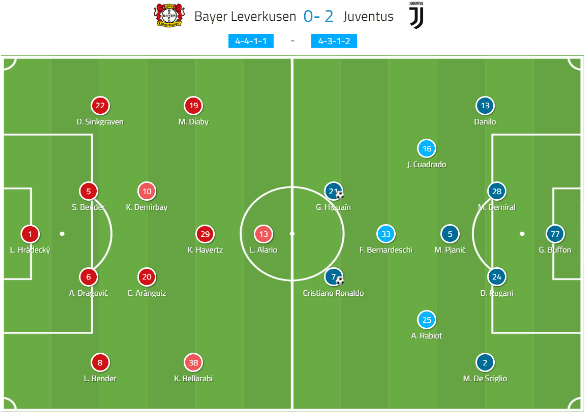
Peter Bosz lined up Leverkusen in a 4-4-2, with the Finn Lukás Hrádecky in net, Lars Bender at right-back, Daley Sinkgraven opposite him and the combination of Aleksandar Dragovic and Sven Bender in the middle. In the midfield, Karim Bellarabi stayed wide right while Kerem Demirbay and Charles Aránguiz played centrally. Moussa Diaby was the left midfielder, but he would slide more centrally, as did the German wunderkind, Kai Havertz, who started at forward with Lucas Alario.
Maurizio Sarri set Juventus out in a 4-3-1-2, starting Italian legend Gianluigi Buffon in goal. His defence was heavily rotated, featuring Danilo and Mattia De Sciglio out wide with Merih Demiral and Daniele Rugani earning the start centrally. Miralem Pjanic played his standard deep-lying playmaker role, flanked by Juan Cuadrado and Adrien Rabiot. Federico Bernardeschi played beneath the two strikers, Gonzalo Higuaín and Cristiano Ronaldo.
Bayer Leverkusen’s wing play
Playing in a wide 4-4-2, Leverkusen set out to progress through the wings. With the Juventus line of three midfielders starting from narrow positions, Leverkusen was able to play into their midfielders, who then had time to turn upfield and run at the Juventus outside-backs. Of the 29 dribbles they attempted, Leverkusen managed to win 19 of them (66%). This tactic was especially effective in the first half, leading to 13 of their 14 shots.
While they attacked the half-space when possible, Leverkusen generally looked to attack the Juventus goal through crosses. On the game, the German side sent 28 crosses, completing 10. That amounts to a 36% success rate.
Juventus struggled to contain the Leverkusen attack in the first half and allowed a high number of shots. Even though most of those shots were half-chances, Leverkusen found a way to stay on the front foot and find pockets of space to send their crosses.
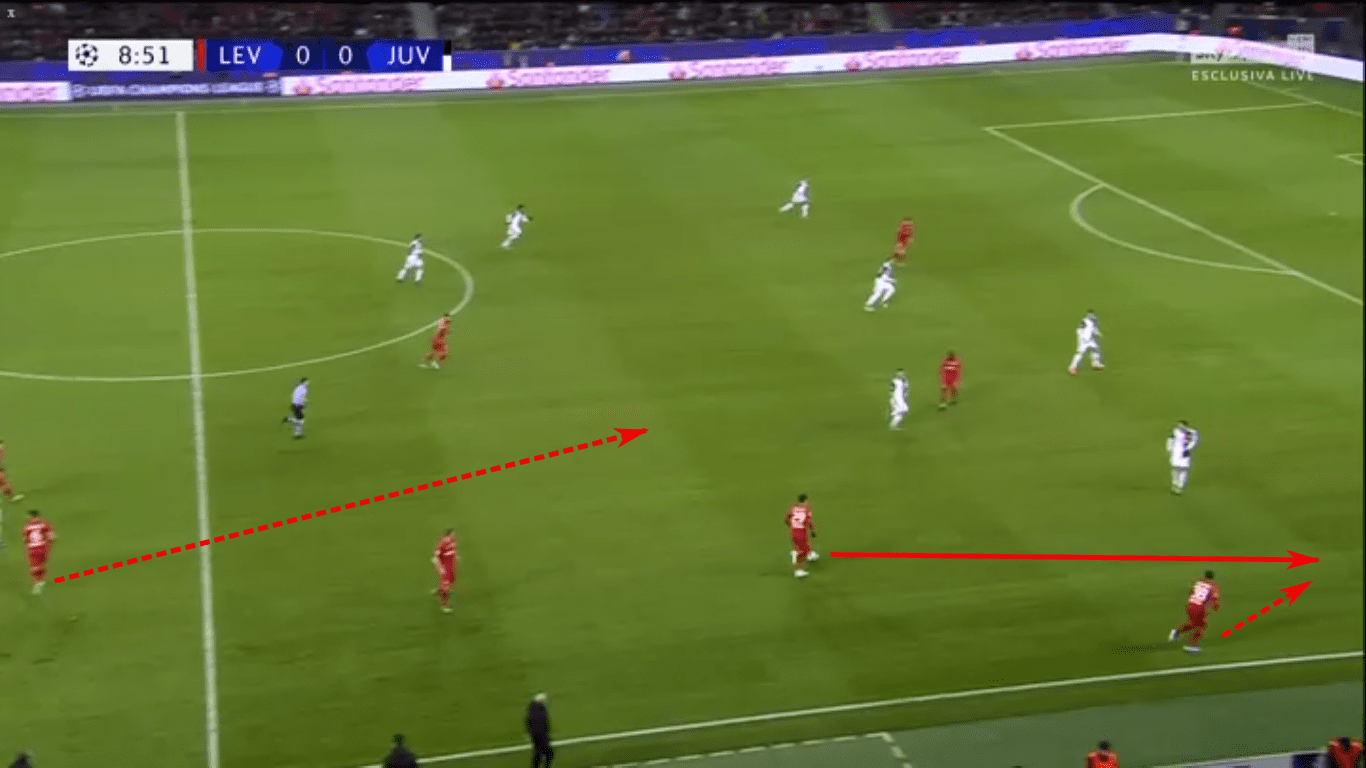
Early in the first half, you could see Leverkusen’s tactics at work as Havertz played Bellarabi into the wing. Havertz supported from the half-space and Aránguiz recovered his ground, moving higher up the field in support of his teammates.
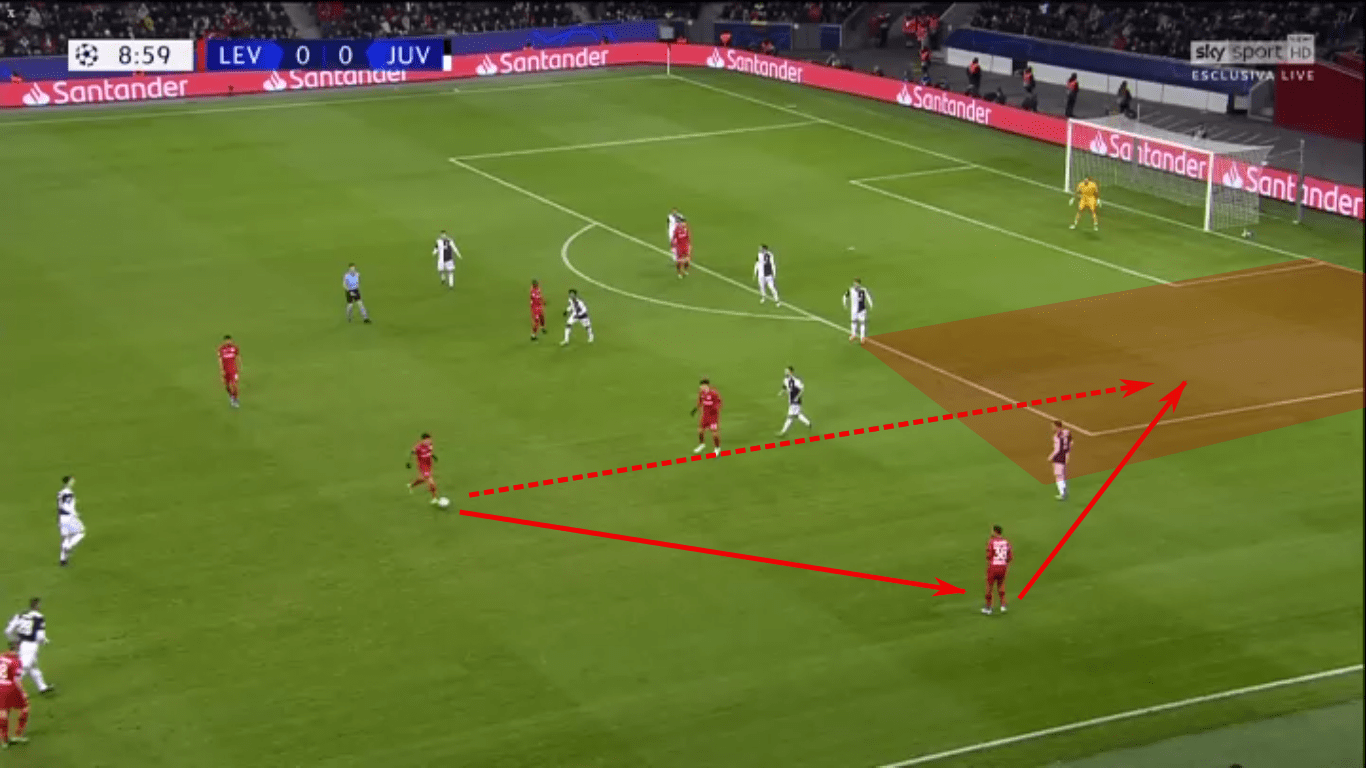
Though Bellarabi had a 1v1 with no cover defender behind De Sciglio, he and Havertz patiently held up play. Juventus had eight players behind the ball to Leverkusen’s four, so holding up play allowed Aránguiz and Demirbay to get forward. The ball was played back to Aránguiz, who pinned the defence, passes to Bellarabi, and continued his run behind the defence.
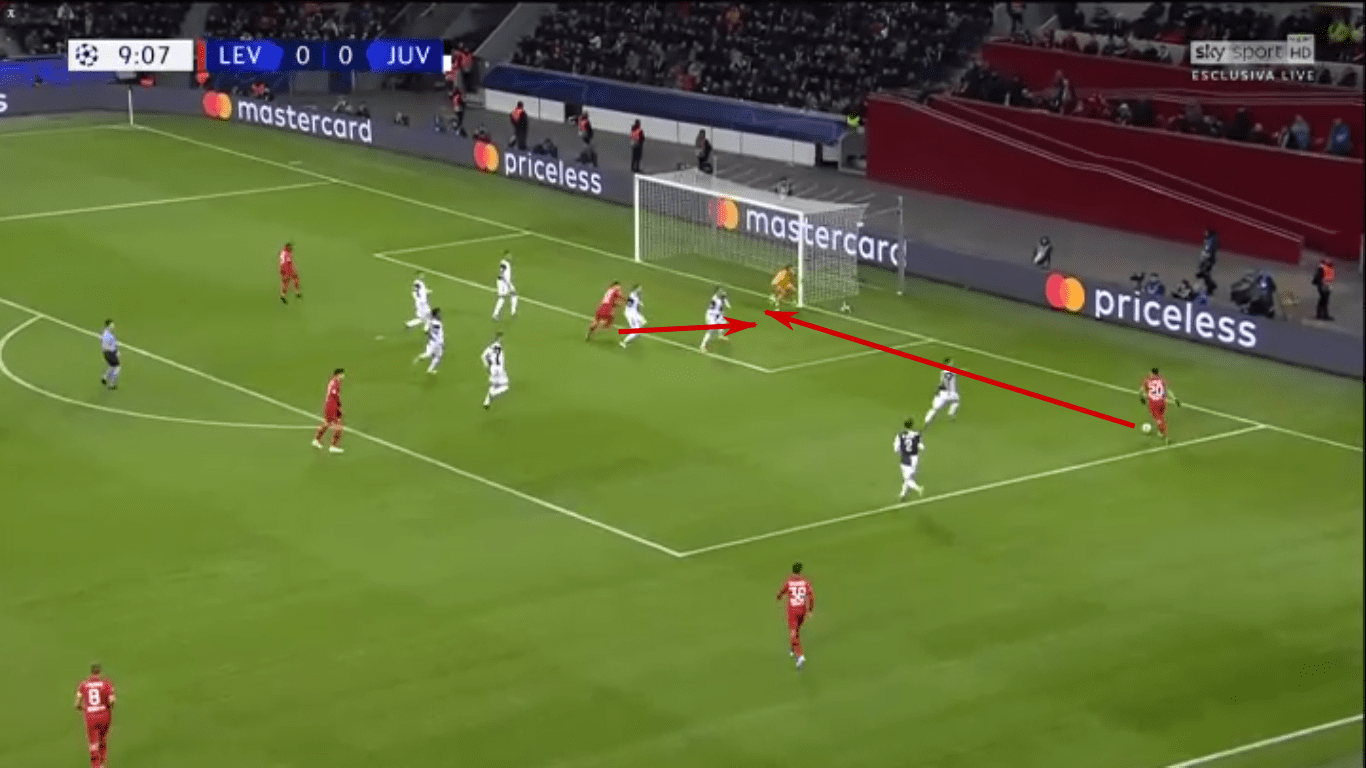
Pjanic assumed Demiral would transition to the first defender, but the Turk remains central, leaving Aránguiz free to penetrate the half-space. He sent an aggressive cross to the near post. Buffon punched it away, but only to the top of the box. Demirbay had a go, but the effort was off-target.
Juventus prioritizes defence
Though Leverkusen was the better team in the first half, credit goes to Juventus for holding them at bay. Of the 13 shots Leverkusen attempted, six were blocked. The seven-time defending Serie A champions had 27 clearances for the game.
After the halftime break, Juventus looked much more confident in defence. Part of that credit goes to more initiative in the attack, relieving pressure on the defence. The other part is better transitional moments and defending in wide areas.
Since Leverkusen was in a 4-4-2, Danilo and De Sciglio showed more of an emphasis in closing the Leverkusen midfielders’ space, looking to get forward in anticipation of those intermediate and long diagonals to the wings. Rabiot and Cuadrado did a better job of halting the progress of Lars Bender and Sinkgraven. Plus, Juventus was able to funnel the Leverkusen attack to the wings and win the ball there.

This run of play highlights Juventus’ defending tactics quite well. First, Hrádecky collected the ball and threw it to Demirbay. Danilo was quick to the cue and put in a tackle that sent the ball negative.
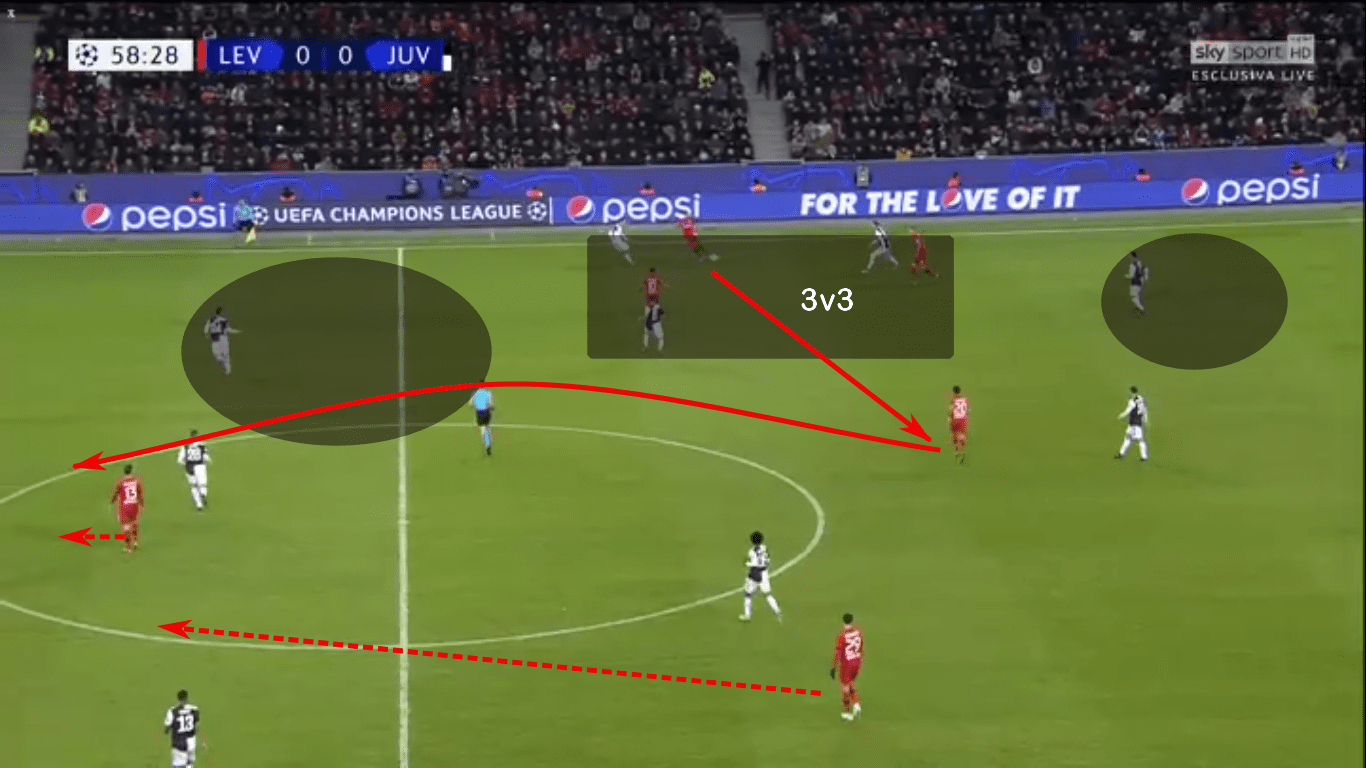
After some time passing the ball among its deepest players, Leverkusen played a long diagonal (a common tactic in this game) to the other wide midfielder. Bellarabi controlled the ball on the wing, but found himself in a 3v3 with no chance of playing forward or backward as Demiral and Ronaldo cut off those passing lanes. Fortunately for him, Bernardeschi was late to eliminate the pass to Aránguiz. Juventus defended the wide space perfectly, but Bernardeschi let them down, allowing the central outlet. Aránguiz played his high target, Alario, to progress from the middle third.
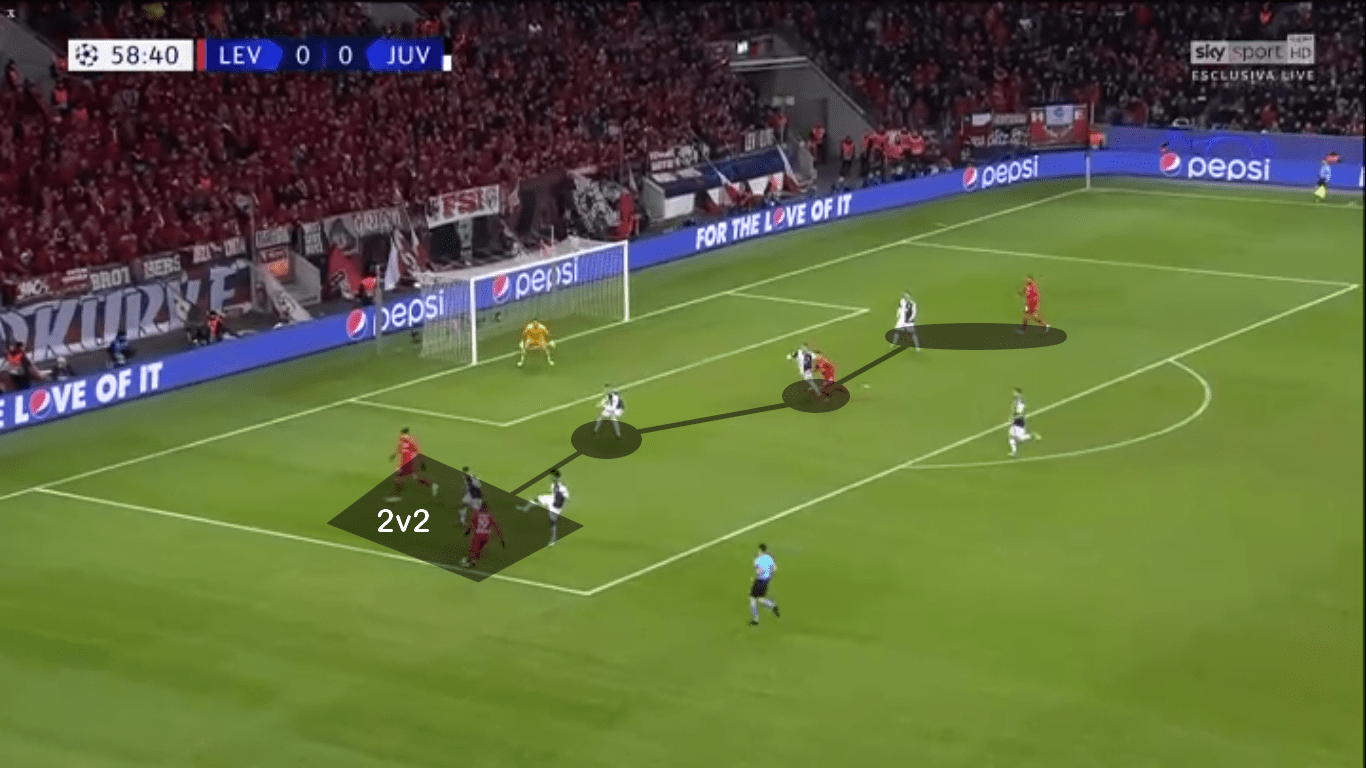
After Havertz claimed the second ball, he and Diaby engaged the Juventus defence. Though a 2v2 seemed like good odds for the attack, De Sciglio and Cuadrado were well prepared to defend against the cross. Perfect containment defence led to Cuadrado’s deflection, which was cleared by Rugani. One additional note is the effective man-marking in the box with Rugani positioned to cover or clear any ball played beyond Cuadrado and De Sciglio.
Mistakes lead to chances
In a game that didn’t produce a lot of chances in the run of play, the best chances on goal came from mistakes as the two teams attempted to play out of the back. Of the 20 shots in the game, eight were the product of mistakes at the back. Additional opportunities were one accurate pass away from an attempt, the most dangerous of which ended in Higuaín sending a pass a metre too far in front of Ronaldo.
Both teams allowed the other to utilize their goalkeeper and centre-backs as deep playmakers, applying pressure with a few of their highest players, then looking to win the progressive pass. This tactic was highly effective as many rushed passes went straight to the defending team.
Another thing to note is that many of the recoveries came in the middle third. With the attacking team usually having their attacking shape, the turnover left them vulnerable. In many cases, the person who intercepted the pass played in front of their nearest opponent, so they had loads of space to attack via the dribble.
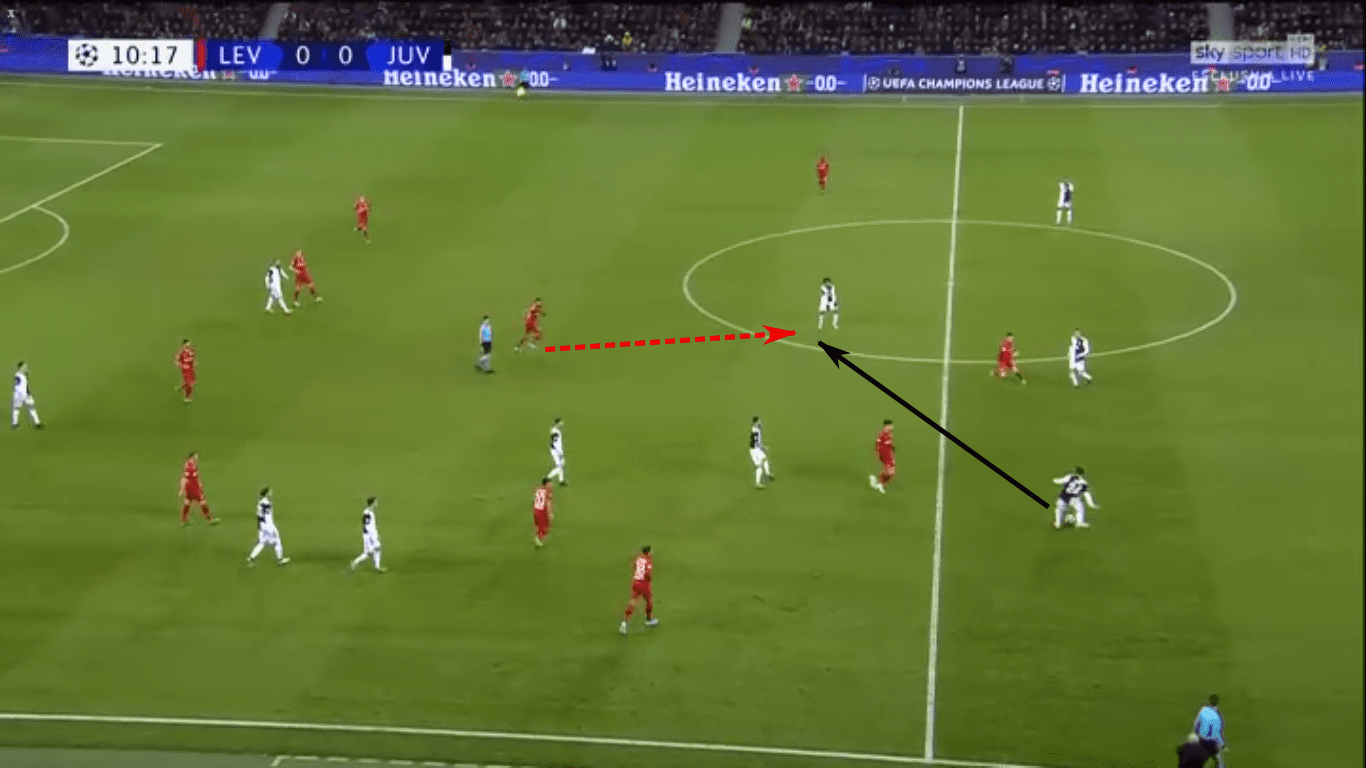
In the 11th minute, Leverkusen had their best chance of the game. Demiral played Cuadrado, which is a perfectly reasonable decision. However, he played Cuadrado’s front foot, which led him into Aránguiz’s path.
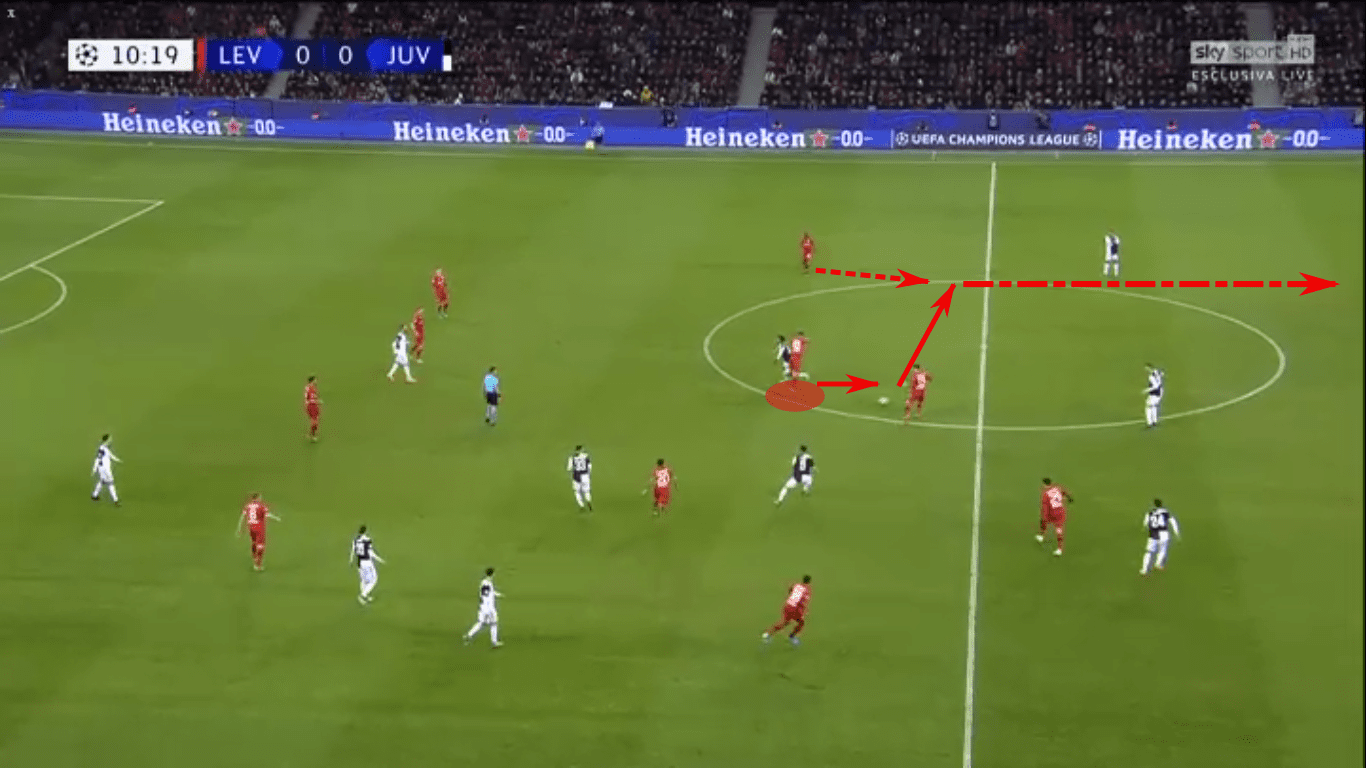
Aránguiz poked the ball to Alario, who played the run of Diaby.
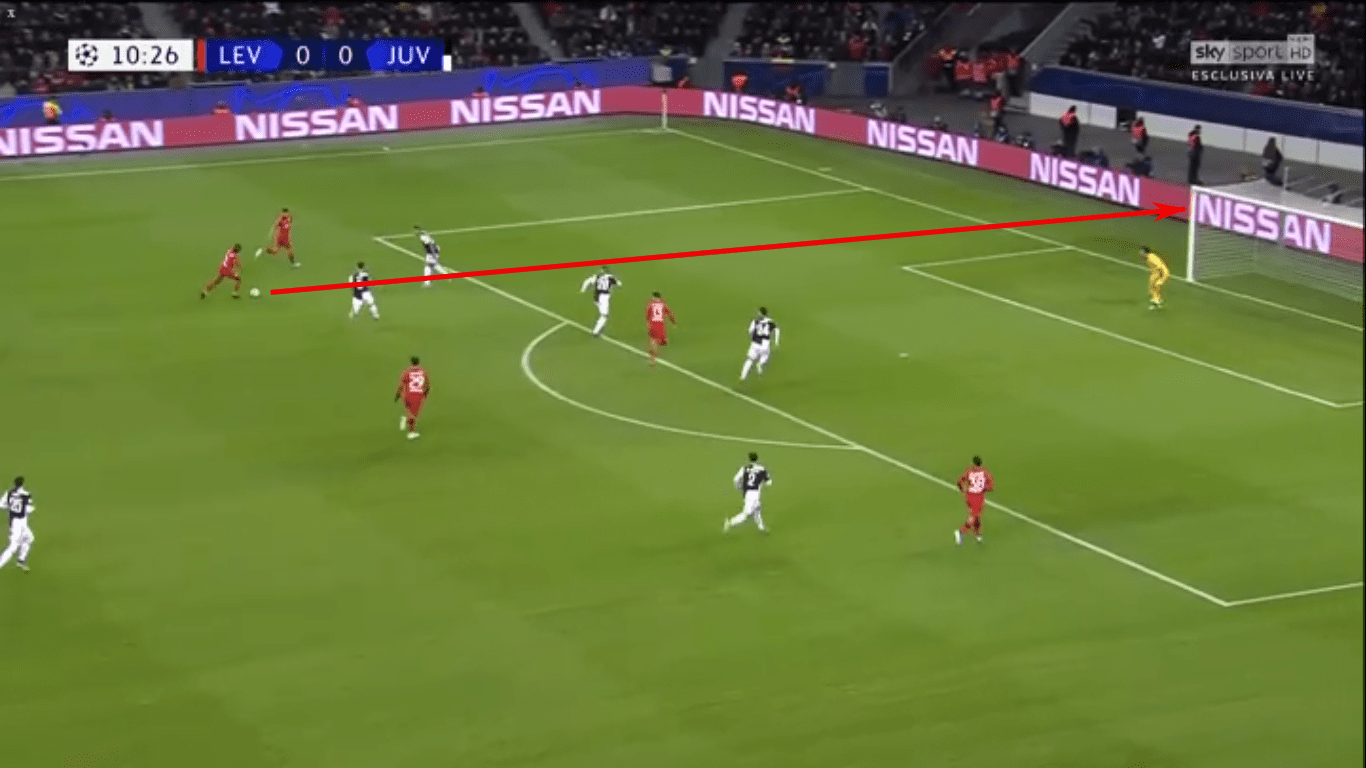
Diaby carried the ball 35 metres before unleashing a dangerous shot. His effort beat Buffon, but rattled off the post. It was the closest Leverkusen came to a goal.
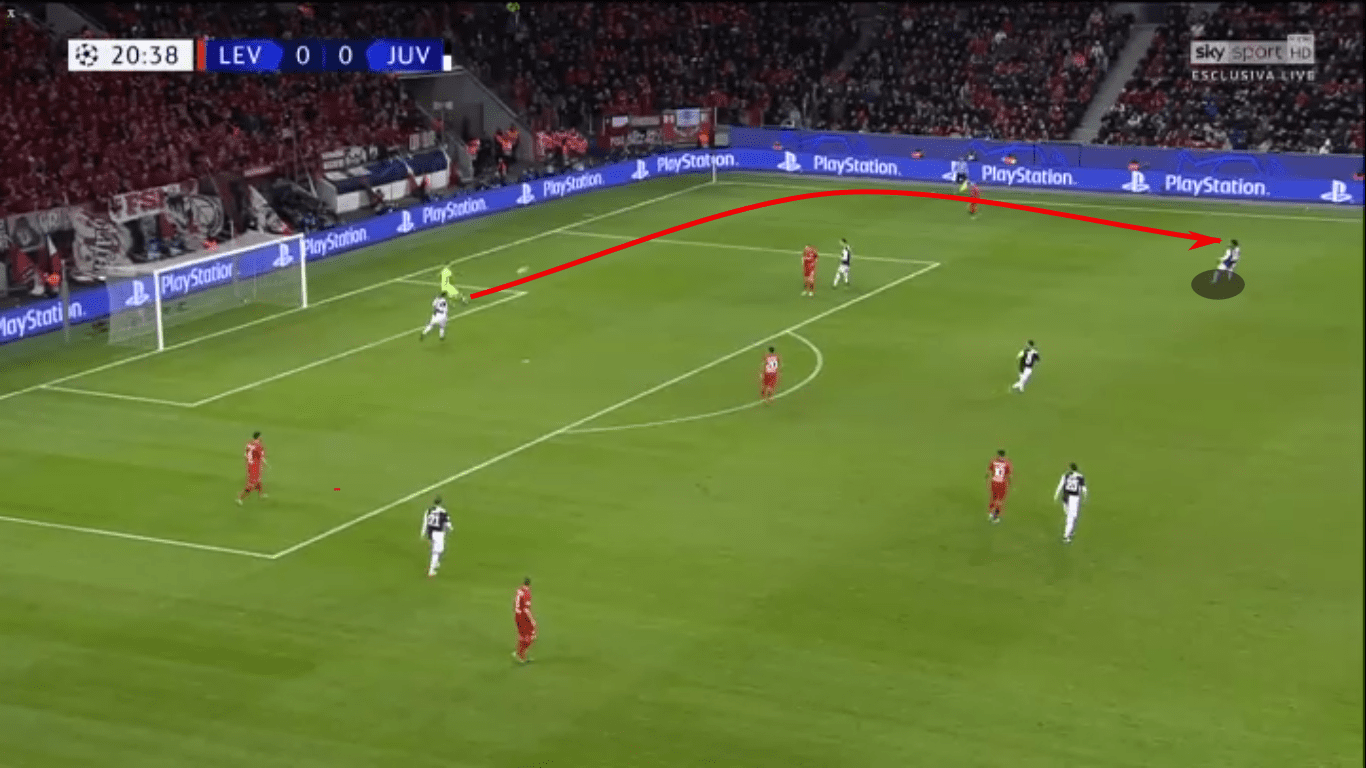
On the other side of the field, Leverkusen attempted to play from the back and dropped the ball to Hrádecky. Under some pressure, he quickly sent the ball forward in an attempt to play Diaby. His pass is poorly hit and intercepted by Cuadrado.
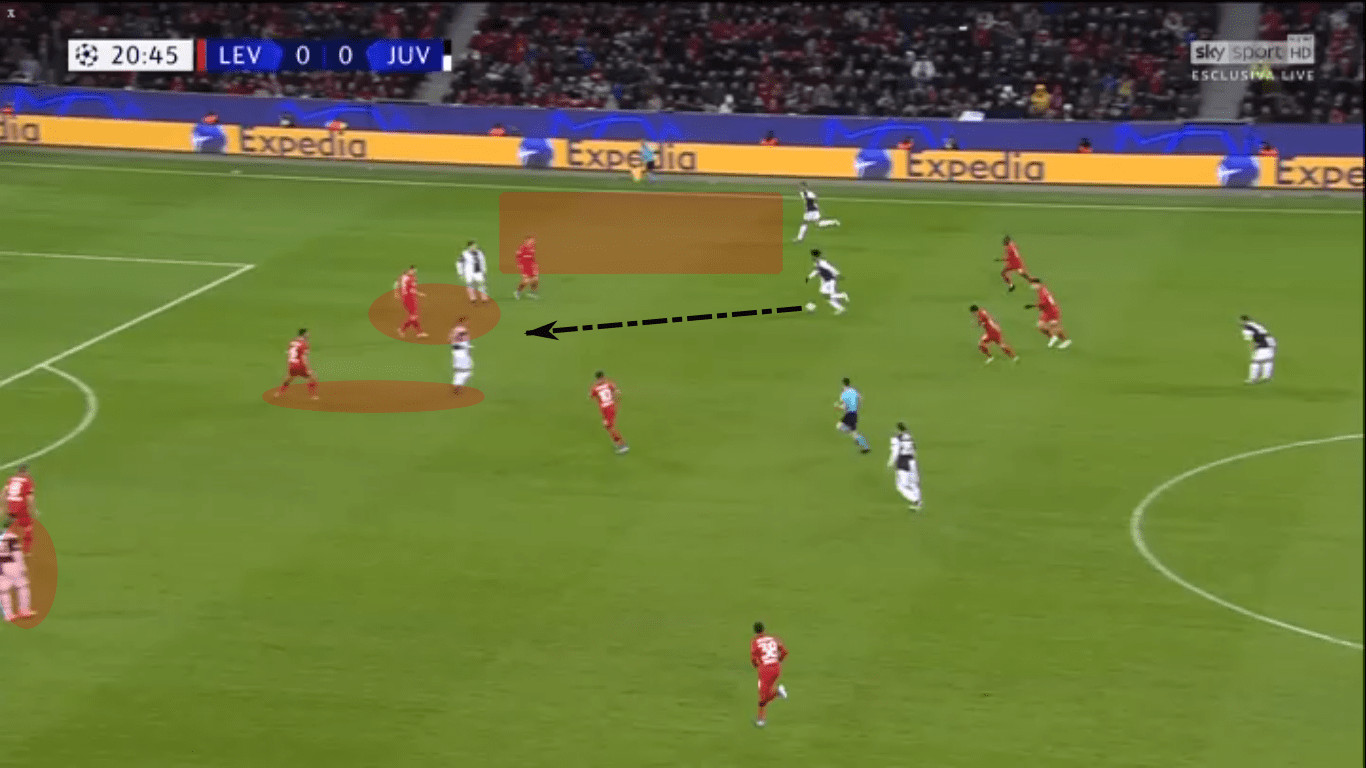
After a brief exchange with Pjanic, Cuadrado received the return pass, cut up-field and took his chance to the goal. The effort went wide, but Juventus preyed on Leverkusen’s mistakes all game.
Conclusion
Leverkusen is off to the Europa League and it’s fair to say they’ll be disappointed in themselves for not taking advantage of Atletico’s poor Champions League form. Home losses to Lokomotiv Moscow and a rotated Juventus side meant six wasted points. With wins in those two games, Leverkusen would have edged out the Spanish giants. Instead, they will settle for the lesser of the two European cups and look for a deep run there.
For Juventus, it was a chance for some of the irregulars to get some playing time. More importantly, Sarri had an opportunity to tinker with his lineup and test some relationships. Against lesser opposition, the combination of Ronaldo, Higuaín and Dybala up top seems like the best bet. The midfield could use some attention though. They never really asserted themselves in this game and lacked cohesion. Bernardeschi does not look suited to play underneath the strikers, Cuadrado’s wide play didn’t offer coverage for Pjanic and the Rabiot-Pjanic connection needs some fine-tuning. Given Juventus’ dearth of injuries, this was the perfect opportunity to experiment, but more work lies ahead for Sarri and Juventus if they’re going to compete for multiple titles this season.

If you love tactical analysis, then you’ll love the digital magazines from totalfootballanalysis.com – a guaranteed 100+ pages of pure tactical analysis covering topics from the Premier League, Serie A, La Liga, Bundesliga and many, many more. Buy your copy of the December issue for just ₤4.99 here





Comments